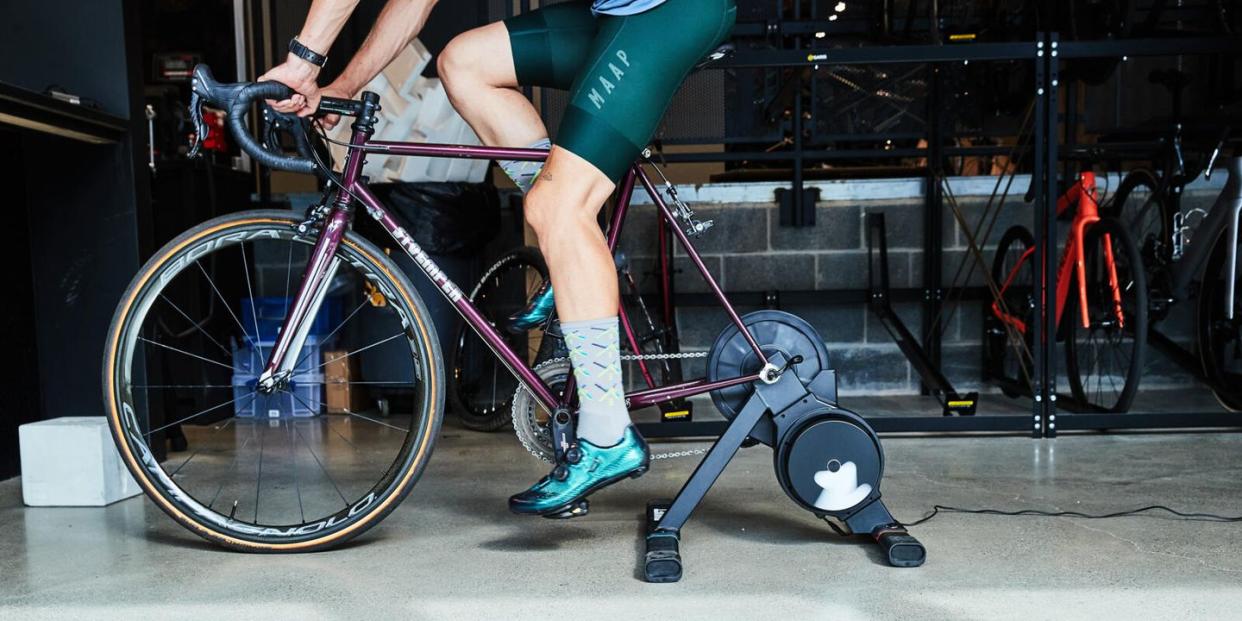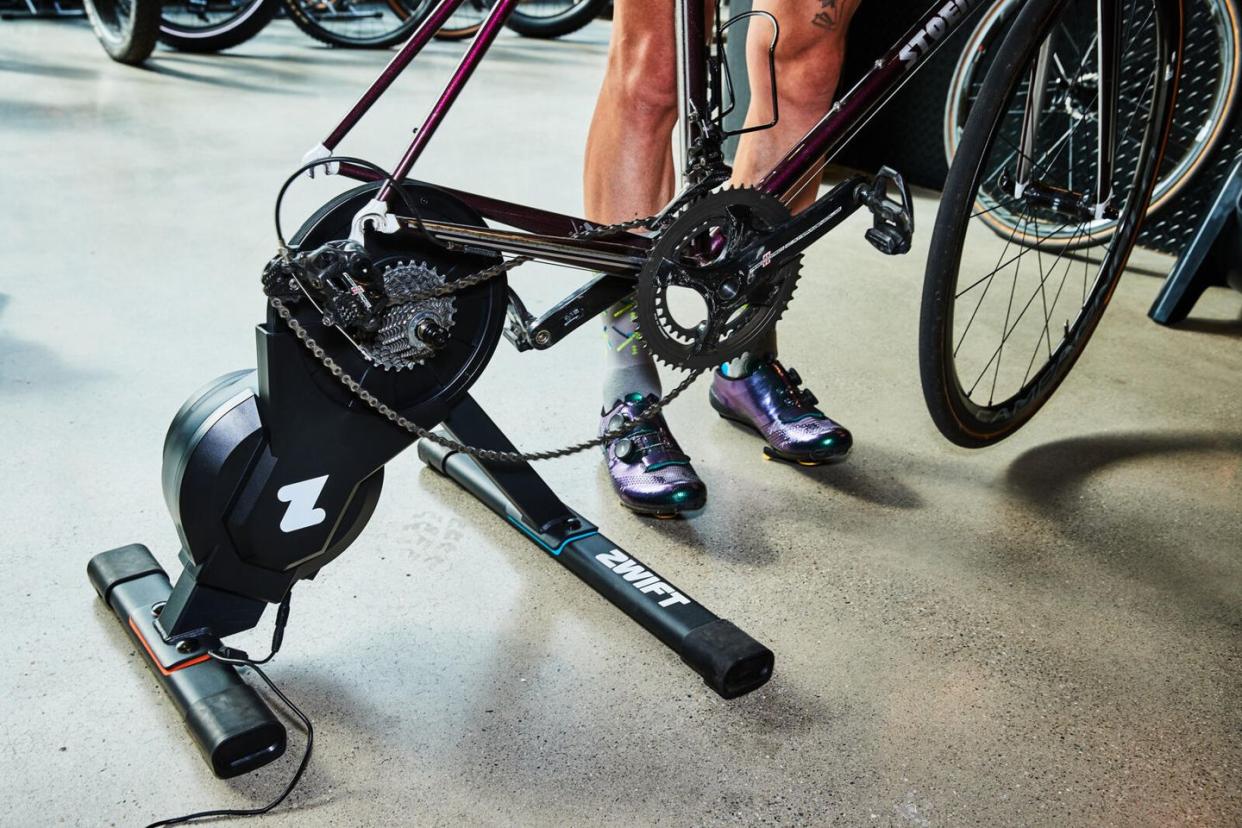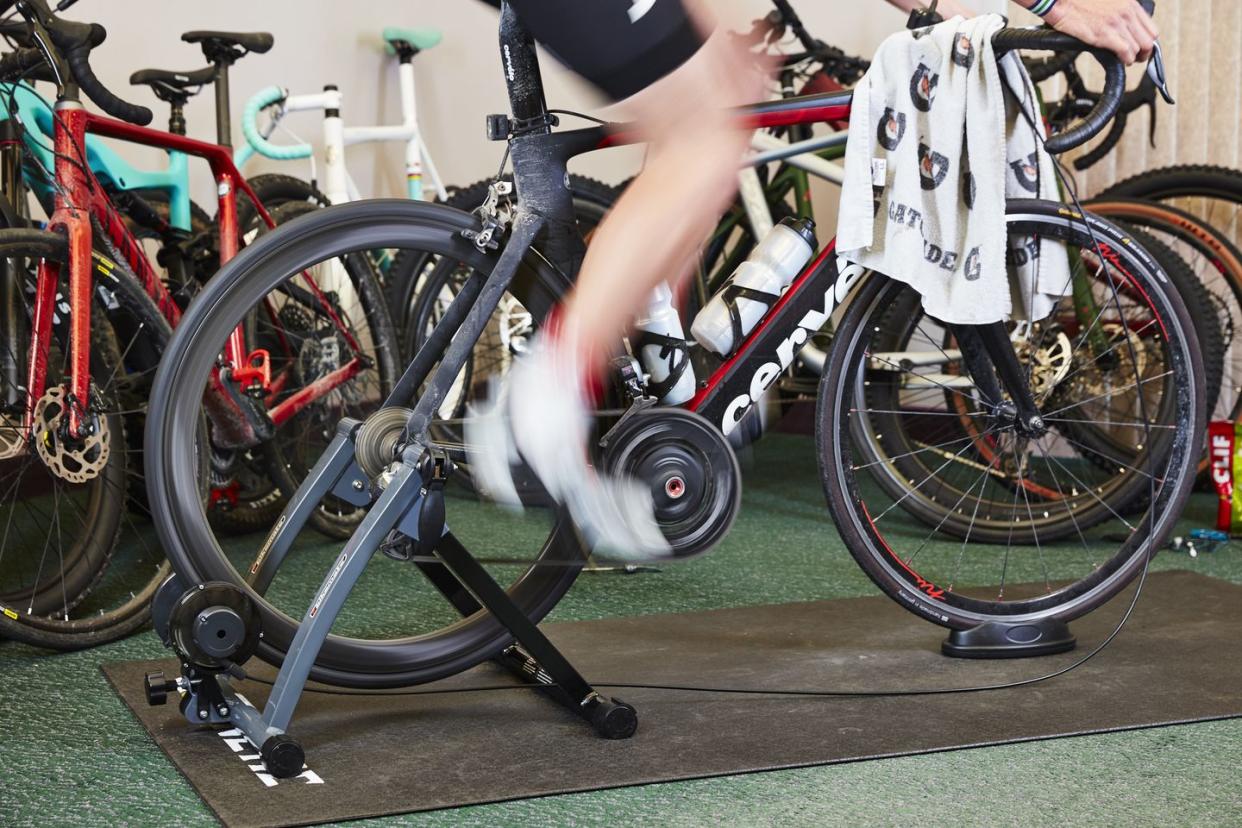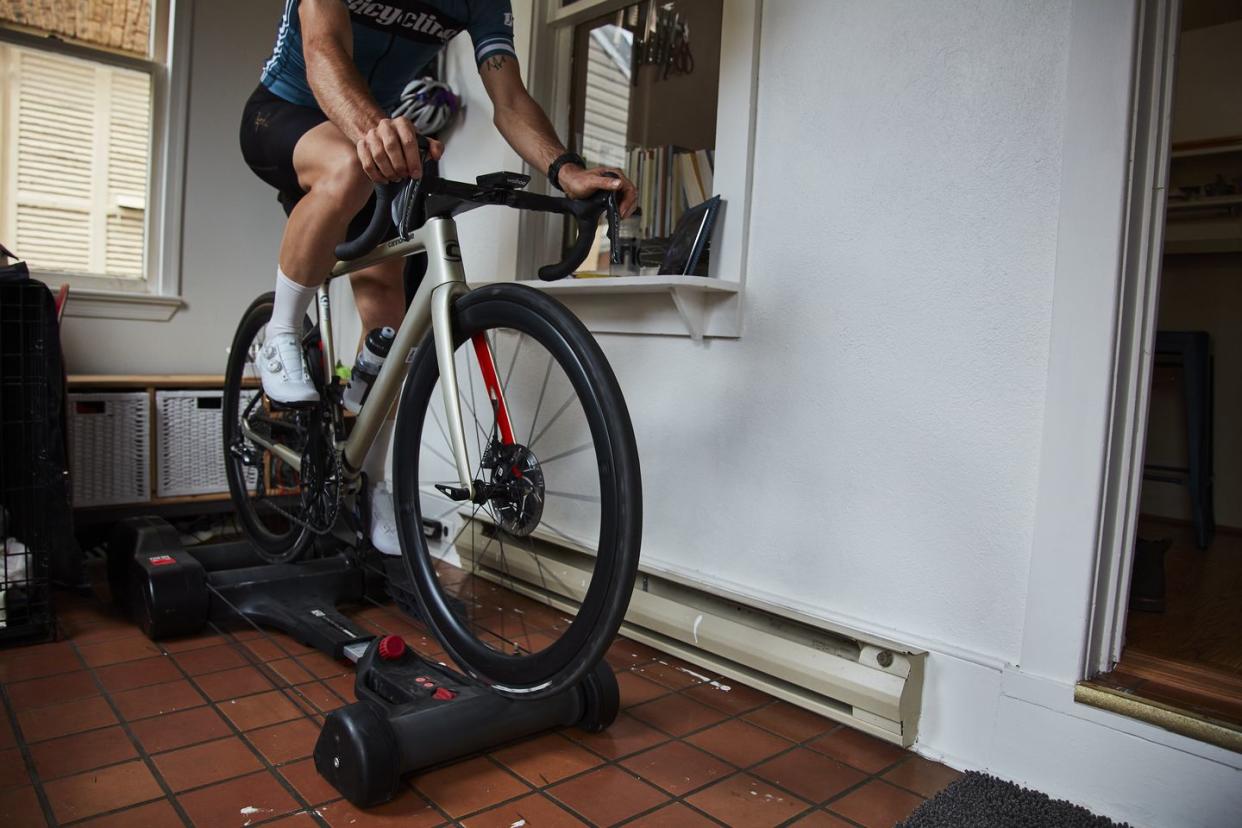The 7 Best Indoor Bike Trainers for $500 or Less

Indoor bike trainers are valuable whether you’re training for an event, just trying to keep a regular riding schedule, or simply prefer the safety of riding inside. What should you get and how much should you spend when many options are available? Many top-of-the-line indoor trainers now sell for over $1,000, and that’s not a realistic budget for most riders.
The good news is that several fully-featured indoor trainers are available for $500, along with many options priced even cheaper. If you are looking for the best of the best indoor trainers, you can find them here or continue reading below as we dig into the more budget-friendly options.
BEST CHEAP INDOOR TRAINERS
TYPES OF TRAINERS
Although there are many variations of each, most trainers come in three basic styles and all three types can be found as “smart trainer” versions as well. The smart trainer label typically refers to a trainer's ability to record and broadcast data to an outside training app such as Zwift, RGT, or Trainer Road (and the others out there).
Power is the most common data metric smart trainers measure, but some can calculate cadence, speed, and more. Some also provide real-time resistance adjustment to simulate virtual hills or automatically run a rider through a workout, while less expensive options simply measure the data. The confusing thing about smart trainers is that some do all these things (and then some), while others only measure one thing and do nothing else. Both these trainers will be marketed as “smart” but might have drastically different prices and features.

Direct-Drive Trainers
These attach to your bike’s rear dropouts, replacing your wheel and providing a direct connection to the resistance unit. These are easily identified because they require a cassette. They’re typically the most expensive but also the most accurate and offer the highest levels of resistance.

Friction Trainers
This wheel-on style trainer places a small roller against the rear wheel and utilize either magnetic or fluid resistance. They tend to be lighter and more portable than direct-drive trainers but are noisier and less accurate. The trade-off comes in cost. You can get a good, smart-friction trainer for about half as much as a direct-drive model.

Rollers
This is the most basic style of bike trainer. Since the bike isn’t held in place (it's perched atop three rollers), they also require the most technique. Resistance can range from almost nothing up to as much as any direct-drive trainer. They are also good for refining pedaling techniques.
WHAT YOU GET FOR YOUR MONEY
In the world of indoor bike trainers, the more you spend, the more connected, feature-rich, and “smart” the trainers tend to be. These features allow trainers to communicate with virtual cycling platforms or training software. Additionally, more expensive models automatically adjust the resistance to simulate a virtual hill or to lock you into a predetermined workout. Here is a breakdown of what you should expect to spend on a trainer if you want some (or all) of these features.
For less than $200, you are looking at a trainer with no electronic connections. These trainers usually feature a mechanical remote that riders use to adjust resistance. However, with the addition of a Bluetooth speed sensor, these trainers can still log virtual miles on Zwift. I go into more detail about this budget Zwift setup here.
Riders spending between $200 to $500 can expect to get a wheel-on smart trainer. Trainers under $300 typically only measure and transmit the rider's power output to Zwift or a training software and will not automatically adjust the resistance to match the virtual terrain or prescribed workout. Riders who can stretch their budget over $300, or find a good sale, will get a trainer that does both power measurement and automatic resistance changes.
THE ZWIFT HUB
Before Zwift released their Hub unit, it was unheard of to find a direct-drive smart trainer for less than six or seven hundred dollars—and that was only if you could find an older generation model on closeout somewhere. Now riders who can spend $500 can get a fully immersive, direct-drive smart trainer that does a fantastic job of replicating the ride experience of a trainer costing twice as much. Plus, unlike many expensive direct-drive setups, Zwift ships the Hub with a cassette installed, saving you upwards of $100 in the price of parts and labor.
WHY SPEND MORE?
With the introduction of Zwift’s Hub trainer, it has become harder to argue that something like the $1,300 Wahoo Kickr V6 (or similarly priced options from Elite, Tacx, or Saris) offers that much more bang for the buck. But like other high-end components or accessories, these trainers add features that might be worth it to some riders. First, these more expensive options offer features (built-in handles, folding legs, and adjustable feet) that make storing your trainer easier. The Zwift Hub has none of these functions.
If you are tight on space and do not have the luxury of leaving your indoor setup in place, the ability to fold up your trainer and carry it easily might be something you care about. Additionally, if you train somewhere with uneven floors, adjustable legs are a crucial feature.
Pricier trainers often have a more realistic road feel and can generate higher resistance. This is worth considering if you fancy yourself a sprinter or are a larger rider that simply generates more power. Finally, pricier trainers typically have more sensitive sensors capable of more accurately measuring a rider's power output (with most claiming 1% to 1.5% accuracy compared to the Zwift Hub’s 2.5%), making them a better choice for very competitive indoor racers.
OUR PICKS UNDER $200
Costway Magnetic Trainer
For riders on a limited budget, this Costway Magnetic trainer is as cheap as it gets unless you can track down the $28 trainer from Aldi we tested a few years back. For less than $100, riders get a wheel-on trainer with eight levels of magnetic resistance that can be controlled by a wired remote. It’s a no-frills option for riders that can motivate themselves and don’t care about having a trainer that measures and records every effort they make.
TacX Antares Rollers
Some riders don’t enjoy the “locked-in feeling” of an indoor trainer. Others miss the sense of balance, engagement, and concentration removed from the equation when you’re on the trainer. For riders like this, rollers are the time-tested alternative. Simple, durable, and designed to help you stay on, these Tacx Rollers are affordable and great for riders looking to try riding rollers without breaking the bank. Out of all the indoor training options, rollers have the steepest learning curve, but the reward can be a much more engaged indoor ride that doesn’t just train your fitness but your pedaling technique as well.
Elite Novo Force
Before smart trainers, this Elite Novo Force trainer was very close to what most riders used for indoor workouts. The design is simple and time-tested, with no built-in electronics at all. Riders can set the resistance to one of eight levels using a wired dial remote which, in conjunction with gear selection on the bike itself, helps establish appropriate levels of resistance. Of course, if you wanted to, you could add a Bluetooth speed sensor to this trainer and rack up some virtual miles. Additionally, if you already have a power meter on your bike, then you’re good to start your virtual racing career with this simple trainer.
BEST CHOICES FROM $200 TO $500
Kinetic Road Machine Smart Trainer
If you only need power data, the Kinetic Road Machine Smart 2 trainer is a great value. While it doesn’t automatically control resistance (for that, check out the Road Machine Control), it does connect with training apps such as Kinetic Fit, Zwift, TrainerRoad, and more, as well as ANT+ and Bluetooth-enabled computers and ANT+ head units. Its stable base with floor-safe rubber feet, 6.3-pound (claimed) flywheel, and a big roller mean it can find a permanent spot in your home, but its foldable legs and wheel-on design make it a convenient race-day traveler, too. It is, unfortunately, a bit loud, like most wheel-on trainers tend to be. But for riders that just don’t have a power meter on their bike but want to get into power-based structured training, it’s hard to beat the value this Kinetic trainer offers.
Snode Indoor Bike
Riders with the space and aren’t interested in taking their bike on and off a trainer might want to consider a dedicated indoor bike option. In this price range, you’re getting a very basic setup with various fit adjustments that help accommodate riders of different sizes. Resistance can be adjusted manually with a dial, and there is a built-in Bluetooth sensor for tracking miles on Zwift. The Snode Indoor bike is an option for indoor riders primarily focused on fitness and exercise rather than virtual racing or tracking power data.
Wahoo Kickr Snap
Wahoo’s entry-level Kickr Snap offers riders quite a bit for $300. It’s a foldable and portable wheel-on friction trainer that measures power output and automatically adjusts resistance for following a workout or to simulate virtual hills. Because it’s a wheel-on trainer, there is no need to remove your bike's rear wheel to set it up. Riders looking for accurate power data need to calibrate the unit before jumping into a workout. The downside of the Kickr Snap is the noticeable lag in recording big changes in rider power, such as sprints or attacks. This is most noticeable during group Zwift activities. Still, for $300, the Kickr Snap is a great, fully featured, smart trainer. It is as good as it gets in the wheel-on trainer category.
BEST FOR $500
Zwift Hub
The Zwift focused on lowering the cost of an immersive Zwift experience with its incredible $500 Hub trainer. The ride itself is quite good. In terms of feel and inertia, it’s on par with the pricier Wahoo Kickr Core. It’s also essentially silent. The only noise you’ll likely hear will be your drivetrain or your fan. The only meaningful critique I can make of the Hub is that it doesn’t fold up or have adjustable legs. But if you’re not tight on space and have pretty even floors, this is the most cost-effective way to get the full-virtual training experience that Zwift and other apps can offer with the ride feel of a direct drive trainer.
You Might Also Like
